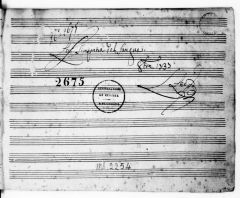The four versions of Leonardo Leo’s opera Demetrio
Roberto Scoccimarro
Thursday, July 10, 2025

Like many other opera composers of the eighteenth century, Leonardo Leo often set the text of a given “dramma serio” several times, realizing the work in different musical versions. Sorting out the diverse versions of an opera can at times become an arduous musicological task, since the available librettos are not always matched by as many musical sources. A particularly complex challenge is presented by the four settings of Metastasio’s Demetrio to which Leo contributed individually or in cooperation with other composers. Although the exact concordance between the musical sources and the known versions is still under reconstruction, thanks especially to the RISM database and the Corago website, which provides access to digitized copies of countless Italian opera librettos, the complex situation can now be disentangled with some success.
Leo’s first setting of Demetrio originated in 1732, when the 38-year-old composer single-handedly delivered an opera for the San Bartolomeo Theater in Naples. This version is documented by a libretto but no complete manuscript score has survived. A full score preserved in Milan (I-Mc Mus. Ms. Noseda F. 92; RISM ID no. 850741732 - RISM Catalog | RISM Online) corresponds to the 1732 libretto up to scene II, 5. After this scene, however, the second act is strongly abbreviated, and in fact ends with the duet “La destra ti chiedo” taken from another “dramma serio” by Metastasio, Demofoonte. On this opera, performed in 1735 in Naples, Leo worked together with Francesco Mancini and Domenico Sarro. “La destra ti chiedo” was contributed by Leo, and became one of the best-known settings of this text in the 18th century. This suggests that the duet, after being performed in Demofoonte, was soon revived in the second version of Demetrio – a very poorly documented version, performed in 1735 at the Teatrino ducale in Torremaggiore (Apulia) for the wedding of Prince Raimondo di Sangro of Sansevero and Donna Carlotta Gaetani of the Dukes of Laurenzano. The fact that the score was abbreviated also seems in harmony with this festive occasion, which was clearly more intimate than the opulent operatic evenings of the Neapolitan monarchy.
The philological investigation becomes particularly thorny in the case of two sources preserved in Paris (F-Pn): MS-2254 and MS-2255. The latter, which has hitherto not been connected with any libretto source for Demetrio, turns out to fully correspond to the 1738 libretto – that is, the pasticcio version whose contributors included (in addition to Leo) Giuseppe di Majo, Nicola Logroscino, Lorenzo Fago, the tenor Angelo Amorevoli, and Riccardo Broschi, brother of the great castrato Farinelli. In MS-2255 (RISM ID no. 840019037 - RISM Catalog | RISM Online), the first act is undoubtedly in Leo’s hand, while in the remaining two several copyists took over, but Leo continues to be present with some annotations as supervisor of the score. In fact, the 1738 setting had originally been commissioned from Leo alone, although for reasons of time the task was eventually extended to other colleagues, resulting in a collective work.
But the philological complications do not end here. Contrary to all expectations, MS-2254 (RISM ID no. 840019041 - RISM Catalog | RISM Online), whose autograph title page reads “La Simpatia del Sangue / 8bre 1737 / L. Leo,” does not feature any music from the “commedia per musica” La simpatia del sangue by Pietro Trinchera and Leonardo Leo, which was staged at the Teatro Nuovo in Naples. Instead, it contains an unidentified symphony in F major, three arias from the “dramma serio” Andromaca, fourteen from Demetrio, and an aria from the “festa teatrale” Decebalo (all composed by Leo), as well as a recitative and aria from an unidentified composition. Of the arias from Demetrio, six appear in the 1732 libretto, one in the 1742 libretto, and three can be found in both librettos, while the remaining ones are not traceable (for various reasons) to any of the known versions. In the case of MS-2254, therefore, the musical numbers do not seem to belong to a single version. Thus, while the 1738 version can be identified with certainty, and for the 1735 setting the hypothesis formulated above seems rather plausible, some part of the intricate network of sources remains obscure. Will perhaps further sources emerge in the future?
Image: Leonardo Leo, La simpatia del sangue, title page, Bibliothèque nationale de France (F-Pn 2254), Available online. Public domain
Share Tweet EmailCategory: New at RISM

